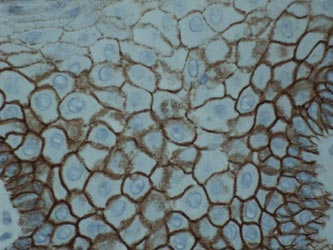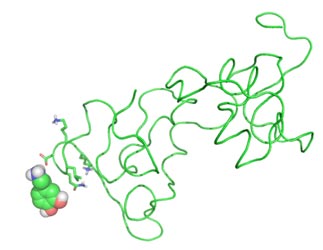BIOLOGICAL PHYSICS RESEARCH
My research effort in biological physics also employs both theoretical and
computational approaches, including statistical mechanics descriptions
and coarse-grained and atomistic molecular dynamics simulations, to study
important biological problems ranging from determining the
mechanical properties of skin cancer cells to understanding protein
misfolding and aggregation. All of the projects described below involve close collaborations with biologists.
Ongoing projects include:
1. Smart, designer, protein-based nanogels
We design, create, and characterize new classes of
stimuli-responsive biomaterials. A distinguishing feature of these
materials is the incorporation of tetratricopeptide (TPR) modules of
defined structure and stability and cross-linkers between TPRs to
create a scaffold with structural integrity. Cross-linking in these
novel materials is governed by specific TPR-peptide
interactions. We are able to design and manipulate the
microscopic components and their interactions with unprecedented
control in these materials. We combine experimental measurements
with coarse-grained computer simulations to understand and define the
macroscopic consequences of particular designs. We use iterative
rounds of design, characterization, and analysis, in which novel
simulation results stimulate successive rounds of experiments, and
the refined experiments suggest further investigative
simulations. This coordinated process will lead to a new generation of
active biomaterials with unprecedented, highly-specific molecular
recognition capabilities and response to external stimuli. Collaborators
on this project include Profs. Eric Dufresne (Mechanical Engineering,
Chemical Engineering, Cell Biology) and Lynne Regan (Molecular Biophysics & Biochemistry, Chemistry).
Schematic of design strategies for protein-based
nanogels. (left) Structure of TPR proteins with each repeat shaded
using a different color. (right) TPR cross-linking strategy. |
Snapshot of a coarse-grained simulation of a protein gel
in 2D. Rigid six-mers possess three sites that can bind other six-mers via mediating linker monomers.
|
A coarse-grained model for a TPR protein (left) and snapshot of a percolating protein gel (right). Green monomers indicate "sticky" attractive sites, while red monomers are purely repulsive. |
|
2. Understanding the structural and mechanical properties of epithelial cells
The goal of this project is to first determine the structural
properties (cell size and shape) and mechanical constraints
(intercellular forces and packing geometry) of normal epithelial
tissue and then identify how these properties evolve during cancer
progression. This work is based on the hypothesis that tumor
formation, and more specifically skin cancer, can be directly linked
to alterations in the physical properties of tissue. There have been
several studies that have tracked the genetic alterations during skin
cancer progression, but few quantitative studies have monitored and
developed a predictive understanding of the dynamics of the physical
properties during the onset and progression of tumorigenesis. Thus,
we lack a quantitative understanding of the physical properties and
mechanisms associated with tumor progression. We will address three
fundamental open questions in this project: 1) Does the structure,
packing geometry, and force-bearing properties of cells and tissues
change during tumorigenesis? 2) Is there a feedback effect, in which
these changes promote the progression of tumorigenesis? 3) How do
interactions between different cell types, such as melanocytes and
keratinocytes, change during tumorigenesis and how do these
alterations affect tissue architecture and tumor progression?
Collaborators on this project include Profs. Marcus Bosenberg
(Dermatology, Pathology), Jose Costa (Pathology, Medicine) and Valerie
Horsley (MCDB).
Magnified image of epithelia. Cells near the epidermis (top) are flat while those near the basal layer (bottom) are more symmetric. Cell
membranes are stained using beta-catenin and appear black, while nuclei appear light blue. |
3. Nanoscale approaches to screening small molecule inhibitors of toxic amyloid species in neurodegenerative disease
Single molecule measurements are uniquely capable of characterizing
the dynamic set of molecular species that are populated during amyloid
aggregation. We will combine experimental single molecule
fluorescence methods with computer simulations to develop a novel
approach to determine how soluble amyloid species interact with small
organic molecules. We will develop our methods using the Parkinson's
Disease associated protein, alpha-synuclein, and the Alzheimer's
Disease associated protein, tau. Using small molecules that have been
identified for their ability to perturb aggregation of these proteins,
we will study their effects on protein conformational dynamics and
oligomerization process. We will specifically address two specific
aims: (1) determine how small molecules affect monomer structures and
dynamics and (2) characterize the effects of small molecules on
oligomerization. The results of these investigations will provide an
ultrasensitive, robust assay for screening small molecules that
perturb soluble pre-fibrillar amyloid species. Thus, if successful,
our proposed research will lead to a transformative change in the way
small-molecule drugs are screened, the ultimate outcome of which is
the development of drugs to treat or prevent Parkinson's, Alzheimer's,
and other amyloid diseases. This work will be performed
in collaboration with Prof. Elizabeth Rhoades (MB&B, Physics).
Snapshot of dopamine (gray spheres) and alpha-synuclein (AS) (green backbone) during the persistent binding period. Binding is mediated by H+ bonds between AS Asp98 and Gln99 with dopamine NH2 and OH groups. Side chains are represented as sticks and nitrogen, hydrogen, and oxygen atoms are colored blue, white, and red, respectively.) |
4. Protein Folding and Misfolding
One of the fundamental unsolved problems in biology is the protein-folding problem: can one determine the native 3D structure of proteins from their unique amino acid sequence? A deeper understanding of how proteins transform from an unstructured denatured state to their native
state would shed light on protein misfolding and aggregation and allow scientists to rationally design proteins to perform specific functions. During folding, proteins navigate an enormously complex free-energy landscape. This high dimensional, rugged energy hypersurface dictates the
rate at which a protein reaches its native conformation, and whether or not it becomes trapped in metastable structures that impede the folding process. The aim of this work is to quantitatively analyze the folding free-energy landscape for several types of proteins, and to understand the
relationships between folding behavior and landscape properties. We will investigate how statistical features of landscapes are coupled to folding pathways and kinetics and the effect of confinement or other surfaces on a protein’s energy landscape. We will simulate both coarse-grained
and all-atom models of proteins to create quantitative, multi-scale descriptions of their energy landscapes. Our general approach will be to seek relationships between features of the energy landscape, such as the number of minima and saddle points, and the protein-folding rate
for a range of proteins including tetratrico peptide repeat (TPR),
Rop, and α-synuclein proteins. The level of quantitative landscape analysis will far surpass previous theoretical and computational investigations and will result in new perspectives on folding pathways and rates. Profs. Lynne Regan and Elizabeth Rhoades from MB&B at Yale will perform single-molecule fluorescence experiments that are able to study the structure and dynamics of single proteins over many orders of magnitude in length and time scales in tandem with the computational studies.
Representative Publications:
(a) A. L. Cortajarena, G. Lois, E. Sherman, C. S. O'Hern, L. Regan, and G. Haran, ``Non-random-coil behavior as a consequence of extensive PPII structure in the denatured state'', J. Mol. Biol. 382 (2008) 203.
(b) G. Lois, J. Blawzdziewicz, and C. S. O'Hern, ``Reliable protein folding on non-funneled energy landscapes: The free energy reaction path'', Biophys. J. 95 (2008) 2692.








